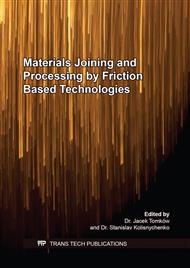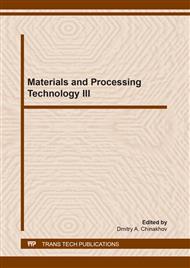[1]
V. I. Vill: Friction welding of metals,; 1962, New York, USA, American Welding Society.
Google Scholar
[2]
Vairis A., Frost M. High frequency linear friction welding of a titanium alloy // Wear. 1998. 217. P. 117–131.
DOI: 10.1016/s0043-1648(98)00145-8
Google Scholar
[3]
Solid state -joining of metals by linear friction welding: A literature review / Imran Bhamji, Michael Preuss, Philip L. Threadgill, Adrian C. Addison // Materials Sci-ence & Technology 2010. Vol.27. No.1. Jan 2011. pp.2-12.
DOI: 10.1179/026708310x520510
Google Scholar
[4]
Linear and rotary friction welding review. Wenya Li, Achilles Vairis, Michael Preuss & Tiejun Ma/ International Materials Reviews. №2. (2016).
DOI: 10.1080/09506608.2015.1109214
Google Scholar
[5]
Linear friction welding of two-phase titanium alloys VT6 and VT8-1 / Medvedev A.Y., Bychkov V.M., Selivanov A.S., Pavlinich S.P., Dautov S.K., Supov A.V. // Welding International. 2015. Vol. 29. № 1. pp.66-69.
DOI: 10.1080/09507116.2014.888191
Google Scholar
[6]
Computer modelling of linear friction welding based on the joint microstructure / Kiselyeva S.К., Yamileva А.М., Karavaeva М.V., Nasibullayev I.Sh., Bychkov V.М., Medvedev А.Yu., Supov А.V., Musin F.F., Alexandrov I.V., Latysh V.V. // JOURNAL OF Engineering Science and Technology Review. – Volume 5. – Issue 3. – 2012. – pages 44-47.
DOI: 10.22226/2410-3535-2012-1-40-44
Google Scholar
[7]
Wen-Ya Li Numerical simulation of linear friction welding of titanium alloy: Effects of processing parameters / Wen-Ya Li, Tiejun Ma, Jinglong Li. // Materials and Design. – 31. – 2010. P. 1497–1507.
DOI: 10.1016/j.matdes.2009.08.023
Google Scholar
[8]
Medvedev A. Linear friction welding process model based on the both consideration of thermal and deformation problems // Vestnik UGATU. – 2012. – №7(52). – pp.139-144. (in Russian).
Google Scholar
[9]
Linear friction welding of Ti–6Al–4V: Modelling and validation / Turner R et al. // Acta Materialia. – 59(10): 3792-3803. – June 2011.
DOI: 10.1016/j.actamat.2011.02.028
Google Scholar
[10]
The magnitude and origin of residual stress in Ti–6Al–4V linear friction welds: an investigation by validated numerical modeling / Turner R., Ward R.M., March R., Reed R.C. // Metall. Mater Trans B. – 43. – 2012. – p.186–197.
DOI: 10.1007/s11663-011-9563-9
Google Scholar
[11]
Numerical simulation of residual stresses in linear friction welded joints / R. Nikiforov, A. Medvedev, E. Tarasenko, A.Vairis // JOURNAL OF Engineering Science and Technology Review. – Volume 8. – Issue 6. – 2015. – pp.50-53.
DOI: 10.25103/jestr.086.13
Google Scholar
[12]
Energy Balance of the Linear Friction Welding Process / Medvedev A., Vairis A., Nikiforov R., Supov A. // JOURNAL OF Engineering Science and Technology Review. – 2012. – Vol. 5. – Issue 3.– pp.20-24.
DOI: 10.25103/jestr.053.04
Google Scholar
[13]
Kuznetsov G. V. Difference methods for solving heat conduction problems: a training manual / G. V. Kuznetsov, M. A. Sheremet. - Tomsk: TPU Publishing House, 2007 .- 172 p. (in Russian).
Google Scholar



